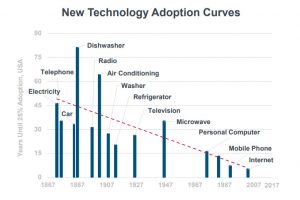Nearly every day, I can scan the headlines on my news feeds and read a report on the dramatic ways that artificial intelligence (AI) is changing the way we work. While the field of AI is wide and evolving, I like the definition given by Nils J. Nilsson, a founding AI researcher at Stanford University:
Artificial intelligence is that activity devoted to making machines intelligent, and intelligence is that quality that enables an entity to function appropriately and with foresight in its environment.”
If you don’t believe me that AI is increasingly all around us, look at these recent examples:
- Robots milk dairy cows for farmers
- Robots cook and prepare your hamburger
- Self-driving luggage that follows you
- Digital assistants in your hotel room
- Computers analyze and prepare legal documents for lawyers and paralegals
- Drones deliver products you purchased online
- Computers scan and read your x-rays for radiologists
For me, this constant flow of innovation is hard to keep up with and makes me question if or how soon my job will be replaced by robots. I think about how leaders will structure jobs and evolve their organization to keep up with these changes. On May 30, Margaret Meeker gave her much-anticipated annual report on Internet trends. During her 34-minute presentation, she covered 294 slides. Slide 143 stood out to me because she described how the speed of technology disruption over the past 100 years is accelerating. For example, while it took Americans about 80 years to fully adopt the dishwasher, the consumer internet has become commonplace in less than 10 years.
For Millennials who are entering the workforce and grew up using Google search engines, smart phones, and WiFi, quickly adapting to new technology is natural and easy. However, the rate of adoption of new technology can be slower for Baby Boomers and Gen Xers who did not always face such rapid rates of change. So how can all generations in the workplace become more open and adaptable to change?
In the field of software development, Beta is the term to describe the final testing phase before the software is formally or commercially released to end users. During this phase, software developers often open up Beta versions of the software to limited user groups to start using and help identify any unknown bugs.
Living in a world and workplace that is constantly influenced and shaped by the dynamics of AI is a lot like living in a perpetual Beta phase. To benefit from this constant innovation, we can learn that “change” will never be “finished” and acknowledge that “how” we perform our work will likely continue to evolve. By building this type of “perpetual Beta mindset”, we will better accept and embrace change – even when the change creates discomfort.
To become a Navy SEAL, soldiers must face and pass and wide range of mental and physical challenges. One of the most challenging tests is to stand, sit, or lay daily on the beach with arms locked with their peers and allow the cold surf to wash over them repeatedly almost to the point of hypothermia. One of the purposes of this exercise is to help them “become comfortable being uncomfortable”. Thus, learning to stay focused and open to learning new ways of working allows us to feel discomfort and build a perpetual Beta mindset.
Over the years, authors and leaders of organizational change have used metaphors such as our iceberg is melting, our platform is burning, and our cheese has been moved to get people’s attention and inspire them to change. Teaching the perpetual Beta is another metaphor you can use to inspire and lead your organizations to adapt and adopt AI and the world of accelerating change.
How is AI changing how you perform your work? How is your organization adapting, and how do does the perpetual Beta metaphor fit your organization?


